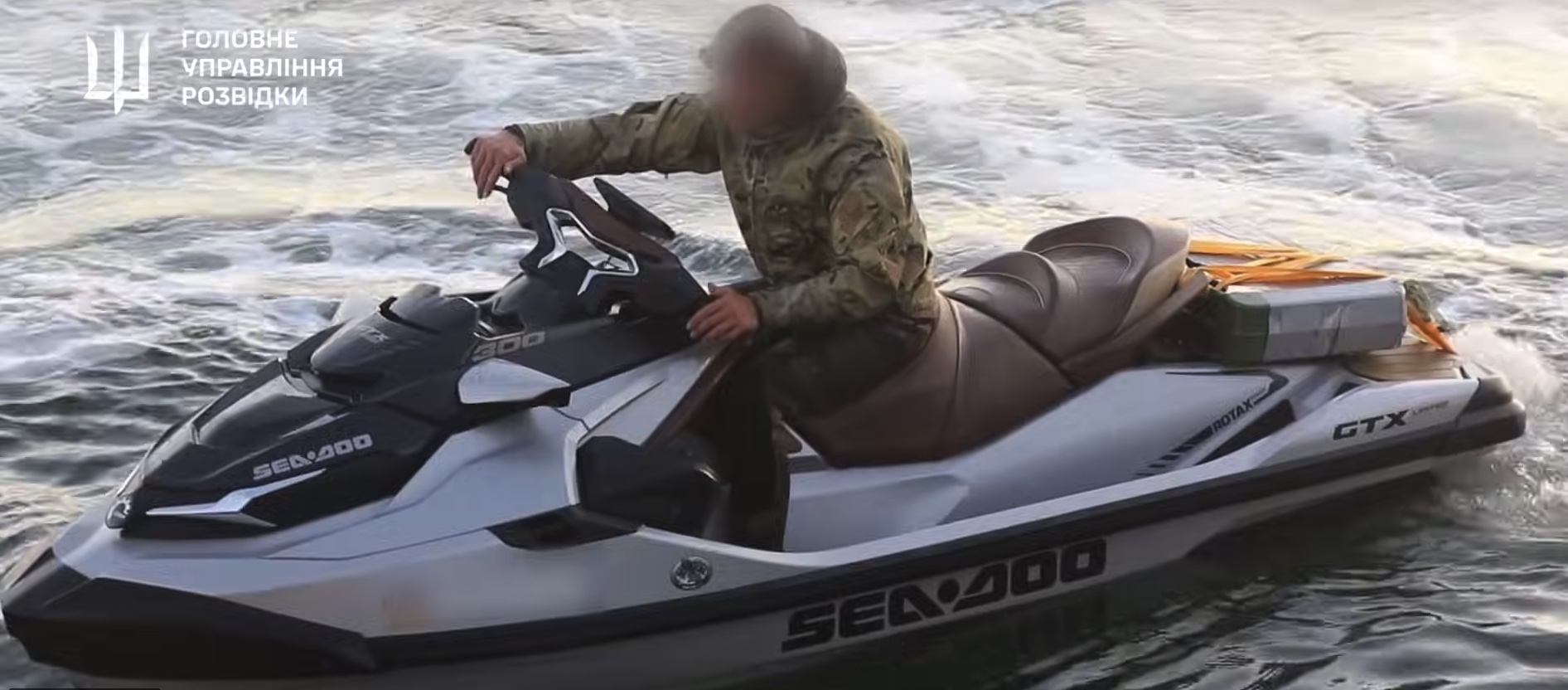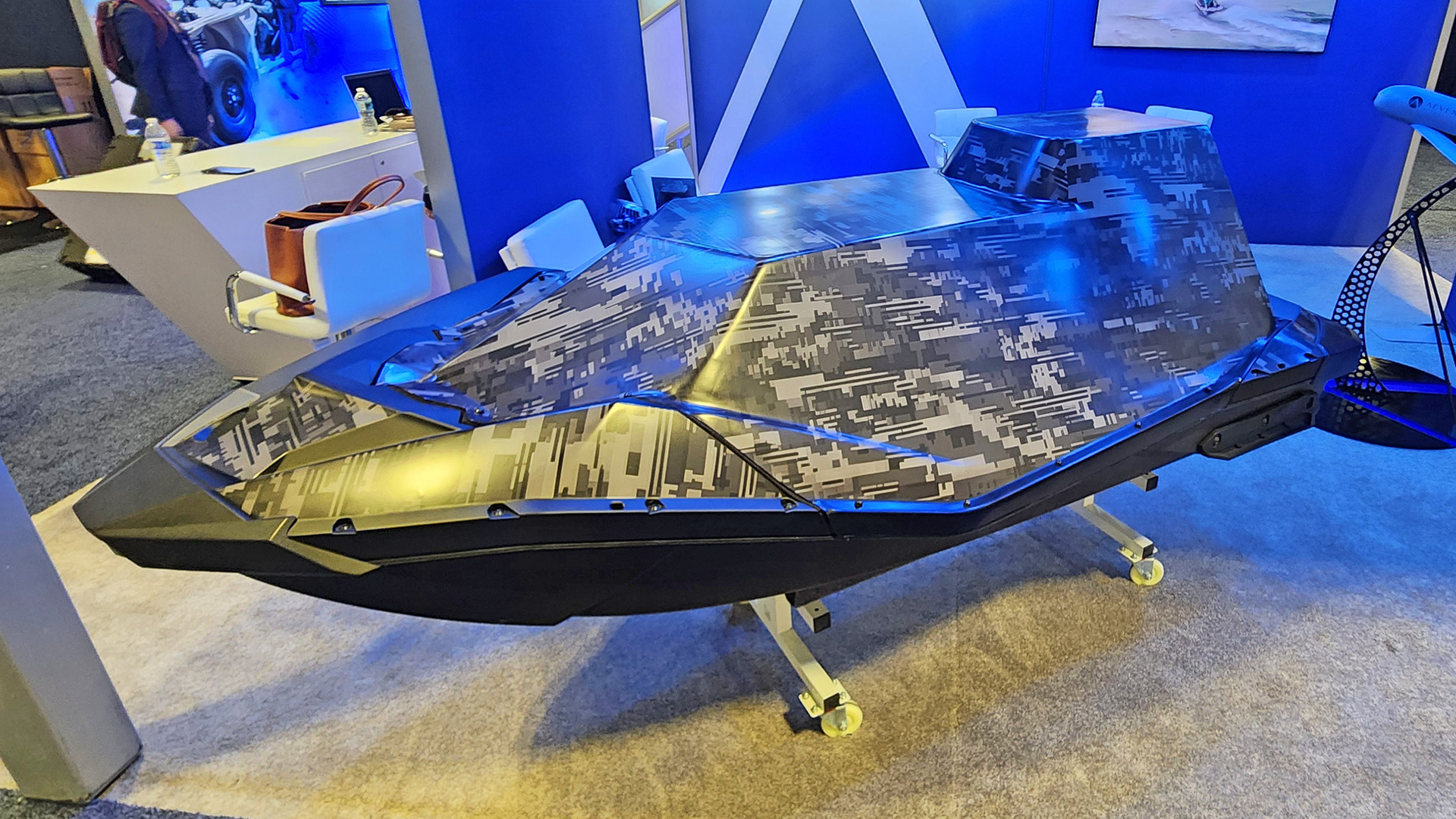The company that makes the mysterious Phoenix Ghost loitering munition has entered the budding market for small uncrewed surface vessels (USVs). Interest in making these types of USVs has accelerated due to the success of Ukrainian uncrewed surface vessel (USV) attacks on Russian warships and concerns over a future fight in the Pacific.
“Unmanned surface vessels are in the news,” AEVEX marketing director Matt Gunn told The War Zone Wednesday during the annual special operations conference in Tampa now known as SOF Week. “You’ve seen the videos online of them with a one-way ticket to a Russian destroyer and it’s sparking everyone’s interest. Our answer to that is the Mako and the Mako Lite.”
As he spoke, Gunn stood next to a working example (minus a few components) of the Mako Lite USV on the SOF Week showroom floor. It is the smaller of two waterjet-powered USVs built on a waverunner-like personal watercraft platform that the company offers. Additionally, AEVEX makes an inflatable Boat in a Box (BiB), powered by a Torqeedo electric motor that can be used to move cargo, Gunn said.

The Mako Lite is being fielded by a customer Gunn would not name.
The Mako line has a wide range of potential uses. AEVEX says the drone boats can be potentially configured for personnel infiltration/exfiltration, logistics support, intelligence surveillance and reconnaissance, and kamikaze missions. “Kits are available to add on to the base USV configurations,” according to AEVEX.
They can be outfitted with auxiliary fuel tanks, an EO/IR camera for First Person View (FPV) control, a UAV launcher, a gimbaled minigun or a guided munition launcher. Ukraine is already using USVs to launch guided and unguided munitions. You can see an examples of that in the videos below.
“The good thing about these is that they’re open architecture,” Gunn stated, describing systems purpose-built to allow easy interchange of software and components. “They allow you to put your products on it, and we don’t box you in with an inability to do that, it’s an ala carte product. You want to put your sensors on it, you want to put your payload on it? We’re here to help you do that.”
AEVEX has a “standard AEVEX avionics stack with open and nonproprietary hardware and software interfaces,” Gunn said.
The company homepage states the USVs use “alternative PNT (position, navigation, and timing) solutions to maintain precise navigation and operational capability in GPS-denied or degraded environments.” The USVs achieve autonomous navigation through “algorithms and sensor fusion,” according to the website.
Weighing in at 895 pounds and 11.3 feet in length, the Mako is the largest of the class, according to an AEVEX spec sheet. It can carry up to 250 pounds of payload and up to 68 gallons of fuel.

The Mako Lite weighs 455 pounds, is nine feet long, and can carry up to 100 pounds of payload with a fuel capacity of up to 30 gallons. The ultimate payload of both USVs is determined by how much fuel is required.
The USV’s waterjet-driven engines are “capable of speeds over 50 knots and tested to sea state 4,” the company website states. They each have a range of 250 nautical miles and an endurance of 12.5 hours.
The BiB is eight feet long, weighs 90 pounds and can carry up to 400 pounds. It has a range of 20 nautical miles and an endurance of up to 15 hours.
Jet skis have long been used by U.S. special operations forces and more recently by the Ukrainians on long-range missions to raid Crimea, which you can read more about in our exclusive interview with two of the participants here. Small, highly maneuverable and fast, person watercraft perform a wide array of special operations missions. Teaming manned types with unmanned ones could also be an attractive capability.

Kamikaze USVs were largely pioneered by Iran, which then transferred the technology to Houthi militants in Yemen. They have really come into its own in the course of the ongoing conflict in Ukraine. The country’s fleet of MAGURA V and other models has destroyed or damaged several Russian warships, providing an asymmetrical advantage to a nation that has no real Navy anymore. You can see MAGURA Vs in action in the video below.

These use cases have AEVEX looking at how its USVs can operate in the Pacific theater, where China has a large advantage in the number of vessels.
“We are always designing for what our customers want,” Gunn said in response to our question about whether the company’s USVs will work as a weapon in the vastness of that part of the world. “The Mako unmanned surface vessel is an exact answer to your question.”
We don’t know right now how much the Mako line of USVs cost, but basing it on a personal watercraft will certainly help in that regard.
“Due to the commerciality of the product, we are able to offer a low price point customizable to user specs at a variety of scales,” is all that Gunn would tell us. Some of Ukraine’s remote-controlled 16-foot-long USVs, as we have previously reported, cost about $250,000 per vessel.

The Pentagon has put out a call for USVs under the umbrella of its ambitious two-year, $1 billion Replicator program. Replicator seeks to acquire “thousands” of attritable, uncrewed systems to counter China’s massive military build-up.
Among other qualities, the Pentagon wants USVs capable of “autonomously transiting hundreds of miles of contested waterspace, loitering in an assigned operating area while monitoring for maritime surface threats, and sprinting to intercept a noncooperative, maneuvering vessel.”
Does the Mako series fit the Pentagon’s Replicator needs? That isn’t clear, but there is increasing demand on many fronts for all types of USVs and ones based on personal watercraft certainly offer unique benefits.
Contact the author: howard@thewarzone.com
